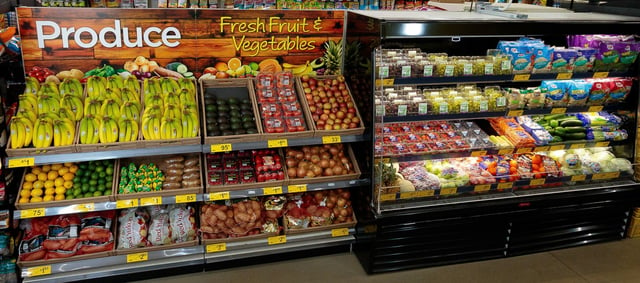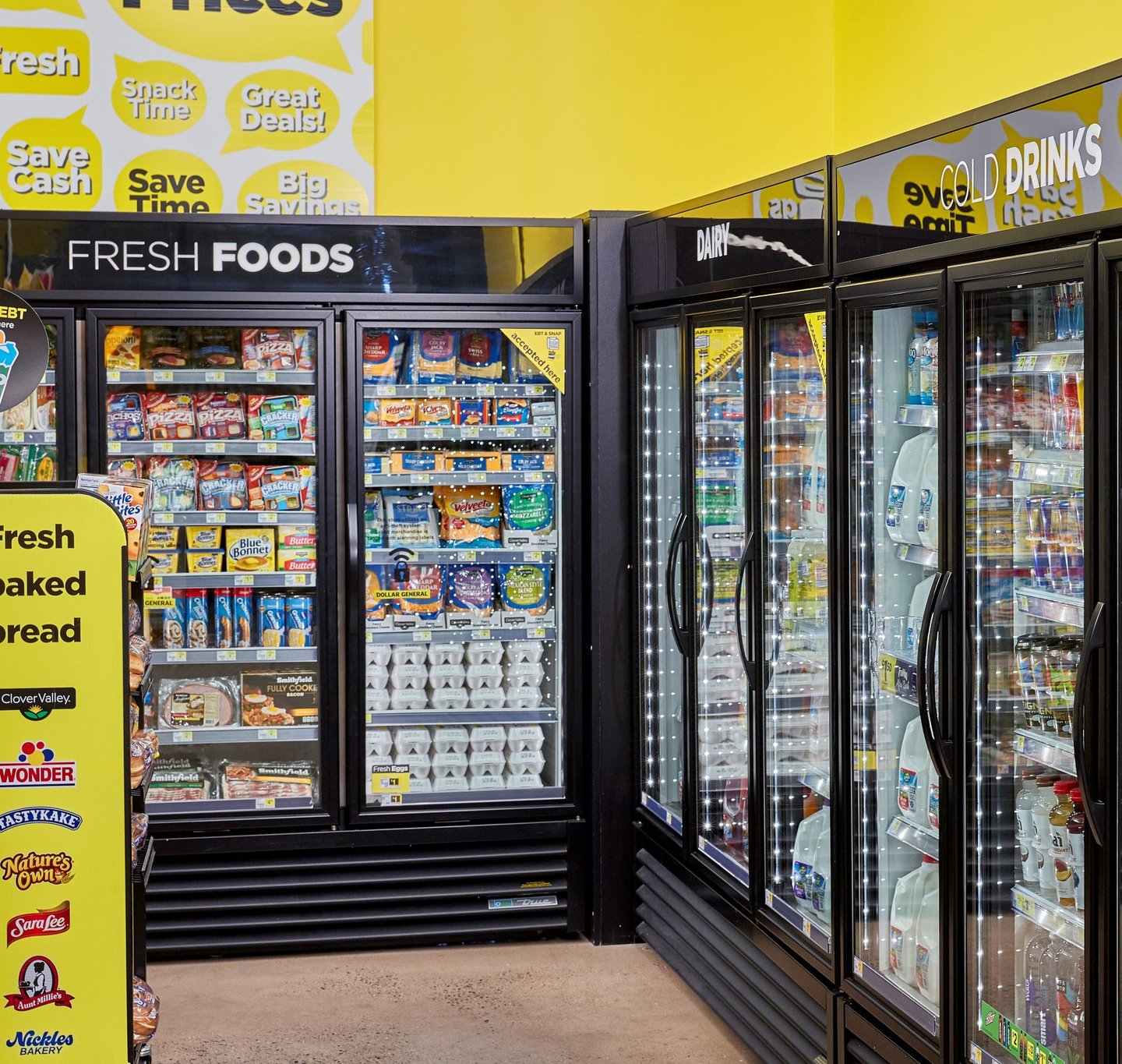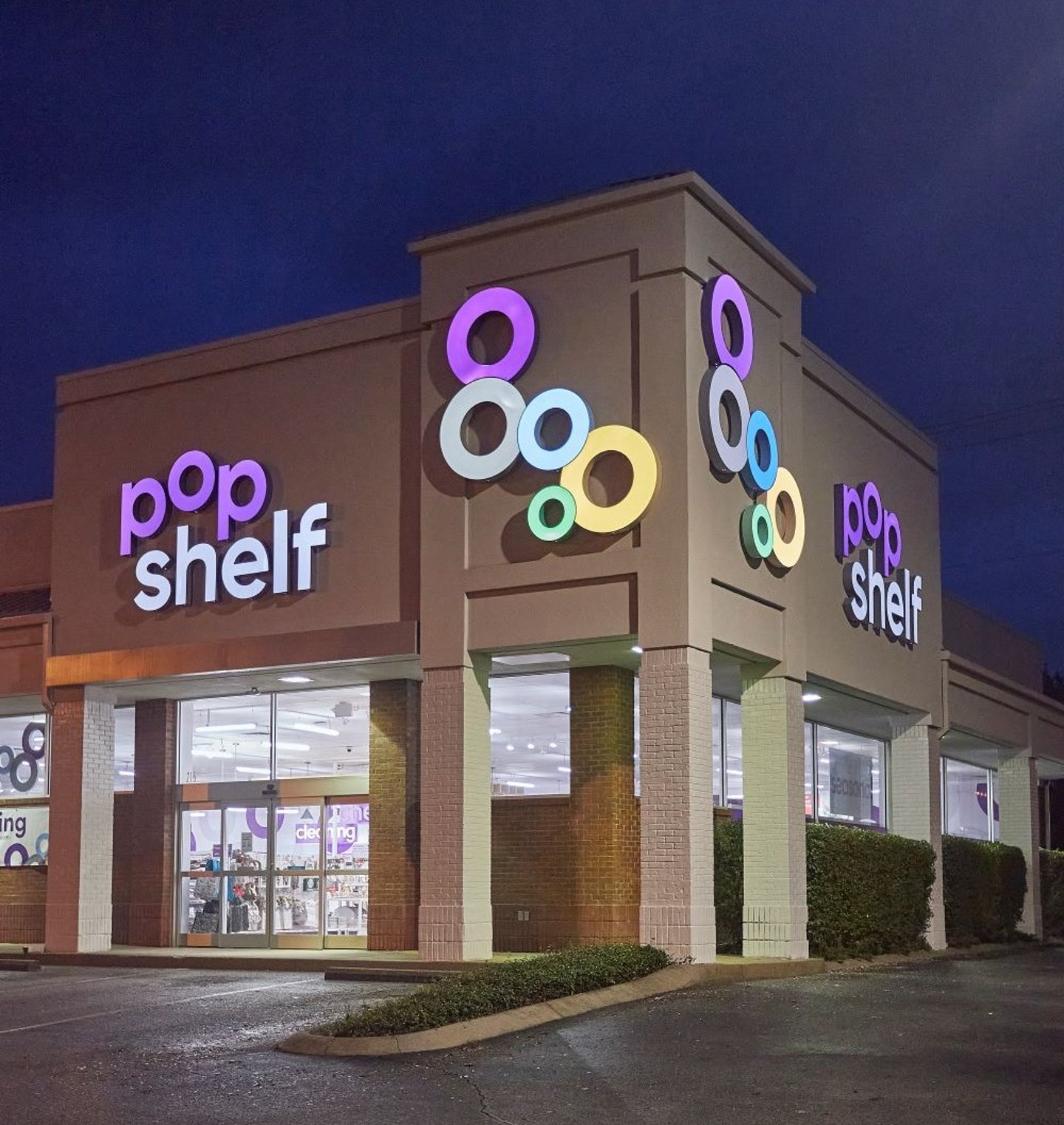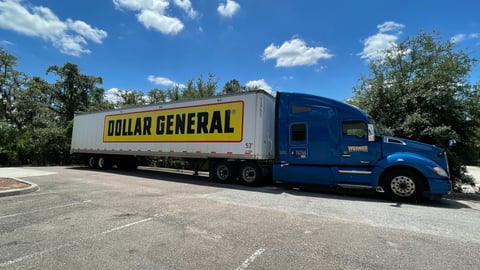2021 Retailer of the Year: Dollar General
Extended DG Coverage
Food and consumables accounted for 77% of Dollar General’s annual sales last year of $33.7 billion. The expansion of cooler and freezer capacity at new and remodeled stores has for several years been described as the Goodlettsville, Tenn.-based company’s most impactful merchandising initiative. Dollar General began selling fresh produce at select stores last year, expanded the program to 2,000 locations this year, and its current plan is to add produce in up to 10,000 stores. Dollar General now self-distributes frozen and refrigerated products from a network of 12 facilities after completing a multiyear rollout of its DG Fresh supply chain initiative ahead of schedule during a pandemic.
Dollar General now sells more food in more places than ever before, thanks to its massive base of 18,000 stores, and will increasingly do so in the future as the company projects that opportunities exist for thousands of more stores. Dollar General’s sales mix and strategic actions are the hallmarks of a grocer, and a successful one at that, but “grocer” isn’t a term that CEO Todd Vasos uses to describe the business.
“We don’t consider ourselves a grocer. We have for many years considered ourselves to be more of a general store,” Vasos tells Progressive Grocer in an exclusive interview. “If you think about our stores and where they’re located, about 75% are in rural or small-town America. From that standpoint, we’re much more than just a grocer by a long shot, because we carry a full array of consumables and nonconsumable-type items.”
The distinction between a grocer and a general store can be subtle, but it’s a view also held by Emily Taylor, Dollar General’s EVP and chief merchandising officer. She views the general store moniker as a way to describe “the magic of the box,” where customers are able to meet a broad range of needs: “Everything from everyday basics, whether it be in household, family needs, all the way over to more discretionary-type purchases, including all health and beauty care.
“But at the same time, we also meet [the shopper’s] needs when it comes to food and feeding her family,” Taylor continues. “That really is the magic of the box, and to do that in such a small footprint, so that it’s convenient for the customer, is really what we work to be.”
Charting the Course
When Vasos arrived at the company in 2008, a decade after Taylor joined in an investor relations role, he brought a background from Longs Drugs, Phar-Mor and Eckerd. He initially served a head merchant and brought the perspective of what was possible with food and consumables, because Long’s and Phar-Mor were nontraditional chain drug operators with expanded food and consumable sets that would later become the norm in the channel.
“What we set our sights on in 2008, as we went through and transformed the company to what you see today, we wanted to make sure that we didn’t turn [Dollar General] into a 7,500-square-foot grocery store,” Vasos says. However, retail is about listening to customers, and over the years, Dollar General’s customers wanted more perishable products. “One of our biggest initiatives, and it has been for many years, has been the cooler initiative, both on the frozen as well as the deli and dairy side of the business, because the consumer is looking for more and more of those type of goods from Dollar General,” he notes.
The same is true of fresh products. Just a few years ago, the notion of Dollar General selling produce seemed a stretch, given the operational complexities of the category and Dollar General’s lean operating model. However, the company decided to leverage its experience with its roughly 120 larger-format Dollar General Market stores and add a limited assortment of produce to select stores. The focus is on the 20% of the produce SKUs that generate 80% of the volume, while steering clear of items prone to rapid spoilage.
“Over the next few years, we’ll have probably upwards of 10,000 or more stores with produce,” Vasos says. “It will be a combination of ambient as well as refrigerated produce, and depending on the size of the store and the competitive set around it, it could be anywhere from 12 feet up to 28 feet.”
The expansion focus early on is on food desert-type locations in smaller towns or rural areas, where the closest conventional grocers may be 20 miles away, he explains.
“It is not our intent right away to go into all of our stores, but I would tell you that if the consumer continues to ask us for [fresh produce], even in our more metro-type settings, we'll take a look at it obviously,” Vasos says.
Getting to 35,000 Stores?
Think a company with more than 18,000 stores must be close to exhausting its expansion opportunities? Guess again. Dollar General has been defying skeptics for a long time, whether the milestone was the opening of its 5,000th store in 2001, the 10,000th store in 2010 or the 15,000th store in 2018. The company recently crossed the threshold of 18,000 locations, but it keeps finding new expansion opportunities, thanks to a flexible format strategy and a willingness to introduce new concepts.
“Within the last year, we updated what we believe our total number of opportunities to be, and it’s another 17,000 locations,” Vasos notes. Embedded in that figure are 3,000 locations of pOpShelf, a new concept focused on nonconsumable products. The first locations opened last fall, and by the end of this year, there could be as many as 50 pOpShelf stores selling a variety of attractively priced beauty, seasonal, home décor, and arts and crafts products.
The pOpShelf concept, along with format experimentation of the flagship Dollar General banner, is why the company continues to defy gravity when it comes to store count. The retailer has DGX stores as small as 6,000 square feet that are designed for urban areas, and its conventional Dollar General stores range in size from the classic 7,300-square-foot units, to the newer 8,500- and 9,500-square-foot locations. Dollar General Market locations can range from 15,000 to 18,000 square feet, with that space allowing for the creation of a combination format featuring pOpShelf departments, which were recently added at two locations. The company doesn’t have a one-size-fits-all approach.
“It opened a tremendous amount of white space for us across America to be able to put a different size box in, depending on the location and demographics of the areas, and what the consumer needs,” Vasos says. “We will continue to innovate, and that 17,000 [square feet] will continue to morph. I think it could get even bigger than that, but we’re not prepared yet to put the stake in the ground.”
Putting the ‘General’ in Dollar General
Dollar General has been crushing it with food and consumables for several years, and recent initiatives regarding the supply chain, increased capacity in stores and growing fresh assortments indicate that will continue to be the case. But general merchandise is a key aspect of the overall appeal of the Dollar General experience, which is why Taylor and her merchant team have for several years been focused on the uniquely Dollar General acronym of NCI.
“We were very proud of the growth rate that we had achieved in the consumable categories over years, but had not attacked the nonconsumable area and tried to grow that in the same way,” Taylor notes. “We had an opportunity to launch our nonconsumable initiative (NCI) and really, for the first time, reconsider the space in our store dedicated to nonconsumable product and reposition it in the mind of the customer.”
The changes involved basic retail techniques like adjusting assortments, fixturing, adjacencies and signing, and the changes worked in ways that also benefited food and consumables.
“We were able to reverse the trend of the negative mix shift that we had been seeing, and are pleased with the growth of nonconsumable categories,” Taylor says. “When we put the NCI initiative in stores, we grow the whole store, and that reiterates the fact that this broader shopping experience is what customers are looking for out of our stores. The entire box becomes more appealing.”
Reimagining the Box and Beyond
Serving others is a phrase used often at Dollar General. It guides the company’s philosophy of delivering convenience and value to lower-income shoppers. It’s also a mindset that causes Vasos and other leaders to look around and question where else the “serving others” philosophy can be put into action.
That led Dollar General to the world of health care, and the intriguing possibilities of how the company can leverage its footprint and technology to help customers live healthier and gain easier access to such services when needed.
"More and more, our consumer is telling us they want some basic health care opportunities in rural America especially, and small-town America, where, again, I use the word ‘desert’ a lot, but there’s a lot of health care deserts out there,” Vasos observes.
He points to new technologies that could make vision checkups and other optometry services possible in a small footprint inside Dollar General’s larger prototype. The same could be possible with basic doctor visits conducted over the internet.
“Telehealth is here to stay, but in rural America, having a wifi connection can be as hard as finding a grocery store,” Vasos says. “We have that ability in our stores so we can deliver that to the consumer where they can feel comfortable to come to us. Think of prescription drugs. Not that we’re going to have a pharmacist on staff, but what if in certain states, we’re able to have a central fill delivered into our stores once a day for the consumer to pick up? In rural America, I think it will be a big advantage and could cut off as much as two to three days on a prescription.”
Dollar General plans to move fast with health care, which is a core component of many grocers’ value proposition, but Vasos cautions that it will take time to find the right approach.
“This is a real long-term initiative, but one I believe will benefit not only our core consumer, but also the shareholders and our employees,” he asserts.
The company has already taken steps from a product standpoint, bolstering assortments of health and beauty care items in advance of introducing more service-oriented offerings.
“We know health care is an opportunity for our customer to be better served, with better access and more affordable solutions,” explained Taylor, “and because of our extensive footprint in a lot of areas that are underserved today, it puts us in a great position to help our customers. That's very exciting as it relates to merchandising within the store.”
Don’t Doubt Dollar General
For much of its history, at every turn, Dollar General has proved skeptics wrong and delivered results. Last year was the company’s 31st consecutive year of same-store sales growth as it reported a pandemic-fueled comp increase of 16.3%. The company’s record of consistency is in jeopardy this year as it laps record gains, but that doesn’t change Dollar General’s long-term trajectory, which is poised to benefit from multiple drivers such as the growing relevance of its stores due to food and consumables and nonconsumables, forays into health care, supply chain efficiencies, and digital capabilities, which are surprisingly sophisticated but often overlooked.
“We’re a company that’s going to deliver on the promise of serving others every day, and across our core consumer, as well as the consumer base in general,” Vasos says. “We get told all the time from not only our core consumer who makes less than $40,000 annually, but consumers who make $50,000 to $75,000 and are adjacent to our core consumers, that our box is becoming more and more relevant to them. We are becoming more and more relevant to a larger subset of Americans than ever before.”
That is especially true as inflation eats into the purchasing power of Americans, and rising fuel costs erode discretionary spending for lower-income consumers. That combination of economic forces has proved beneficial to Dollar General in the past, enabling the company to grow during good times and bad, and overcome doubters along the way who would question the company’s growth prospects.
Taylor recalls having many of those conversations back in 1998, when she joined the company’s investors relations department and there were 3,169 stores.
“We spent a lot of time explaining why people needed a store like Dollar General, because it wasn’t well understood by those who might not live in some of the communities we traditionally serve,” Taylor recounts. “We also answered questions about ‘Have you reached the point of saturation?’ We absolutely didn’t believe that at the time, and it turns out we were right.”









